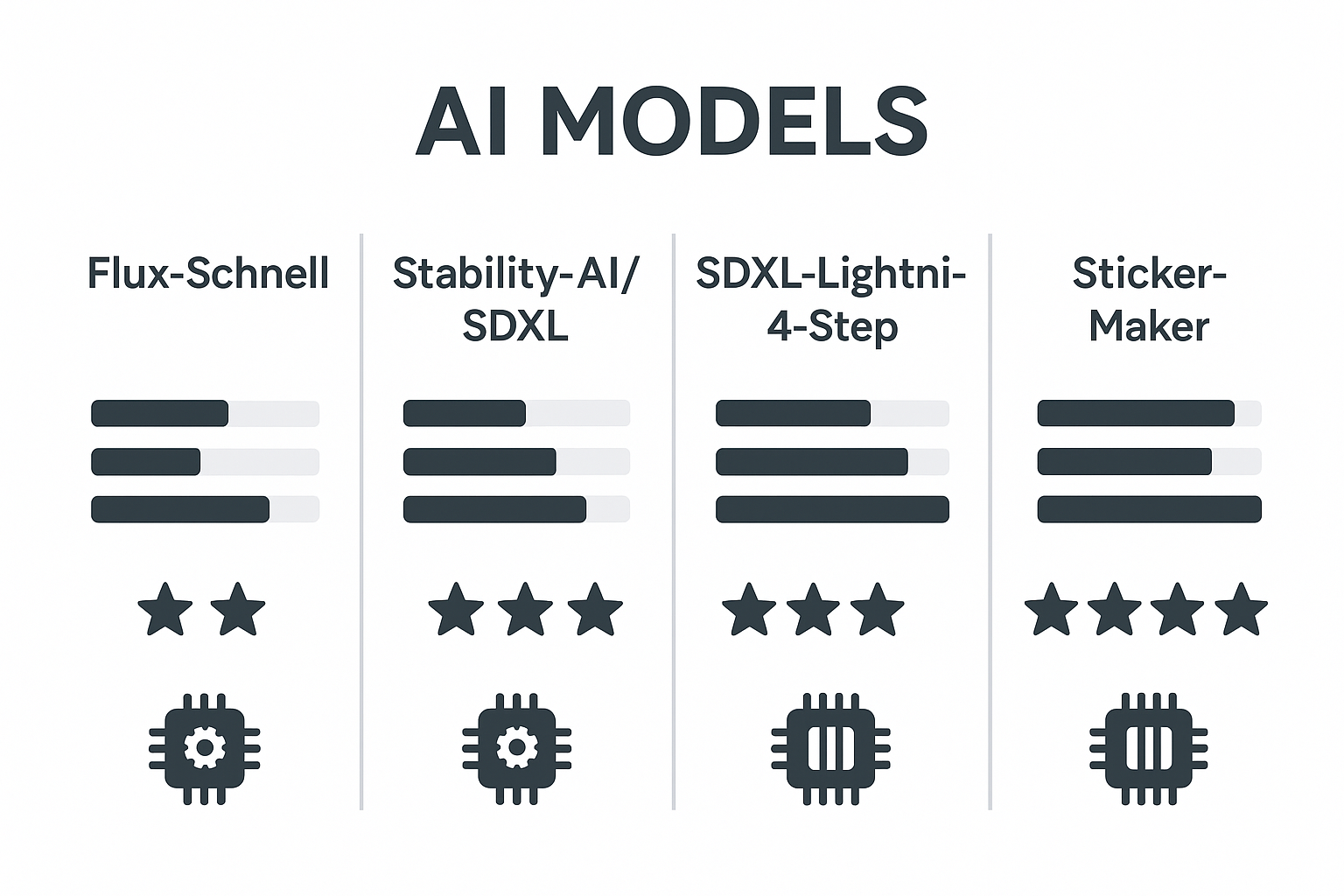
The artificial intelligence image generation landscape has evolved rapidly, offering creators and developers unprecedented possibilities for visual content creation. This comprehensive analysis examines four prominent image generation models: Flux-Schnell, Stability AI SDXL, SDXL-Lightning-4step, and Sticker-Maker, comparing their technical characteristics, application scenarios, and performance metrics.
1. Flux-Schnell: Balancing Speed and Quality
Technical Overview
Flux-Schnell (German for "fast") represents a breakthrough in rapid image generation technology. This diffusion model achieves remarkable generation speeds while maintaining competitive image quality, making it an attractive option for real-time applications and high-throughput workflows.
Key Features
- Ultra-fast inference: Optimized architecture for reduced generation time
- Efficient memory usage: Lower VRAM requirements compared to traditional models
- Versatile output: Supports various aspect ratios and resolutions
- Prompt adherence: Strong text-to-image alignment capabilities
Best Use Cases
- Real-time image generation for interactive applications
- Rapid prototyping and concept visualization
- High-volume content creation workflows
- Resource-constrained deployment environments
2. Stability AI SDXL: The Gold Standard for Quality
Technical Overview
Stable Diffusion XL (SDXL) from Stability AI represents a significant advancement in the Stable Diffusion family. With its larger parameter count and refined architecture, SDXL delivers exceptional image quality and coherence across diverse prompts and styles.
Key Features
- High-resolution output: Native 1024x1024 generation capability
- Superior detail rendering: Enhanced fine-detail reproduction
- Robust prompt understanding: Advanced natural language processing
- Extensive fine-tuning ecosystem: Large community of specialized models
Best Use Cases
- Professional artwork and illustration
- Marketing and advertising content
- Architectural and product visualization
- High-quality print materials
3. SDXL-Lightning-4step: Speed-Optimized Excellence
Technical Overview
SDXL-Lightning-4step is a distilled version of SDXL specifically optimized for ultra-fast generation. By reducing the required denoising steps from the typical 20-50 steps to just 4, this model achieves dramatic speed improvements while retaining much of SDXL's quality.
Key Features
- 4-step generation: Minimal denoising steps for rapid output
- Quality preservation: Maintains SDXL's visual fidelity
- Consistent results: Reliable output across different prompts
- Easy integration: Compatible with existing SDXL workflows
Best Use Cases
- Time-sensitive creative projects
- Interactive applications requiring quick feedback
- Batch processing of large image sets
- Mobile and edge device deployment
4. Sticker-Maker: Specialized for Digital Stickers
Technical Overview
Sticker-Maker is a purpose-built model designed specifically for creating digital stickers and emoji-style graphics. This specialized approach allows for optimized generation of clean, vectorized-style images with transparent backgrounds.
Key Features
- Transparent background support: Native alpha channel generation
- Clean vector aesthetics: Optimized for simple, bold designs
- Consistent style: Specialized training for sticker-appropriate outputs
- Small file sizes: Efficient compression for digital distribution
Best Use Cases
- Social media sticker packs
- Chat application emojis
- Brand mascot creation
- Gaming assets and UI elements
Performance Comparison
Speed Metrics
- SDXL-Lightning-4step: ~2-3 seconds per image
- Flux-Schnell: ~3-5 seconds per image
- Sticker-Maker: ~4-6 seconds per image
- Stability AI SDXL: ~8-15 seconds per image
Quality Assessment
- Stability AI SDXL: Highest overall quality and detail
- SDXL-Lightning-4step: Near-SDXL quality with speed trade-offs
- Flux-Schnell: Good quality with excellent speed balance
- Sticker-Maker: Specialized quality for its target use case
Resource Requirements
- Sticker-Maker: Lowest VRAM usage (~4GB)
- Flux-Schnell: Moderate requirements (~6-8GB)
- SDXL-Lightning-4step: Standard requirements (~8-10GB)
- Stability AI SDXL: Highest requirements (~10-12GB)
Choosing the Right Model for Your Needs
For Beginners (Budget-Conscious)
Start with SDXL-Lightning-4step for the lowest cost option, or FLUX-Schnell for the best speed-quality-price balance. These models allow extensive experimentation without breaking the budget.
For Professional Commercial Work
Choose FLUX-1.1-Pro as the current best overall model, or Google Imagen-4 for excellent lighting and detail. Both offer professional-grade quality suitable for commercial applications.
For Text-Heavy Designs
Ideogram-v3-Turbo is unmatched for generating images with readable text, logos, and typography-focused designs.
For High-Resolution Needs
FLUX-1.1-Pro-Ultra supports 4K resolution, while NVIDIA Sana ($0.16/image) offers up to 4096x4096 pixels for large format applications.
For Specialized Applications
Sticker-Maker for transparent backgrounds, Recraft-v3-SVG ($0.08/image) for vector graphics, and Recraft-v3 ($0.04/image) for multiple artistic style support.
For High-Volume Production
Luma Photon Flash or Minimax Image-01 provide excellent value for content creators needing many images at reasonable quality.
Future Outlook
The evolution of these models reflects broader trends in AI image generation:
- Increasing focus on inference speed optimization
- Specialized models for specific use cases
- Improved prompt understanding and artistic control
- Better resource efficiency for widespread adoption
As the technology continues to mature, we can expect further improvements in the speed-quality trade-off, making high-quality image generation accessible to an even broader range of applications and users.
Each model serves distinct needs within the AI image generation ecosystem. While SDXL sets the quality benchmark, Lightning-4step and Flux-Schnell democratize access through improved speed, and Sticker-Maker proves the value of specialization. The choice ultimately depends on your specific requirements for quality, speed, and application context.
Understanding these trade-offs enables informed decision-making whether you're building commercial applications, creating artistic content, or developing the next generation of AI-powered creative tools.